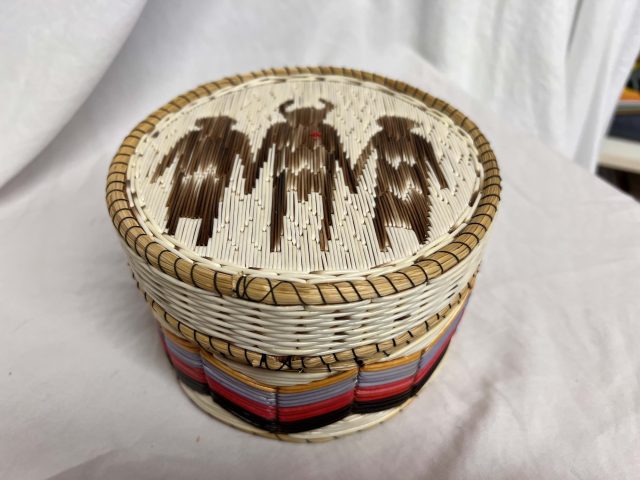The first major traveling exhibition dedicated to Anishinabe porcupine quill art is now on view at the Harbor Springs Area Historical Society Museum in Harbor Springs, Michigan. Titled Gaawii Eta-Go Aawizinoo Gaawiye Mkakoons / It’s Not Just a Quill Box / Anishinaabe Gaak Gaawiiyikewin Zhichiganan / Anishinabek Porcupine Quill Art, the exhibition features over 90 artworks drawn from both public and private collections, including the MSU Museum’s extensive holdings and archives built over 40 years of research and programming through the Michigan Traditional Arts Program.
This fully bilingual exhibition which is presented in Anishinabemowin and English celebrates the creativity, skill, and cultural continuity of contemporary Anishinabe artists from Michigan, Wisconsin, Minnesota, and Manitoulin Island, Canada. It honors the generations of elders and ancestors who have passed down this intricate art form and highlights the enduring relationships between teachers and learners, the connection to natural resources, and the resilience of Indigenous traditions in the modern era.
“Quillwork is more than just a beautiful art form—it’s a reflection of our identity, our teachings, and our deep relationship with the land,” said Minnie Wabanimkee, Tribal Elder and Photographer. “Every piece carries the voice of our ancestors and the care of those who continue this practice today. It’s powerful to see our traditions honored in this way.”
Co-managed by Wabanimkee and Dr. Marsha MacDowell, Curator of Folk Arts at the MSU Museum and Director of the Michigan Traditional Arts Program, the exhibition was developed through close collaboration among Native artists, archivists, language specialists, elders, MSU faculty, and curators including MSU Museum’s Dr. C. Kurt Dewhurst. A Native advisory committee ensured the cultural integrity and authenticity of the exhibition.
In addition to the artwork, visitors can explore videos and photographs documenting the harvesting of materials and the quill art-making process, as well as interactive panels, hands-on activities, and a recreation of a master artist’s workstation.
“This exhibition gives voice to generations of Anishinabe artists who have sustained and enriched this art form, even when it was nearly lost,” said Dr. Marsha MacDowell. “It’s a testament to their creativity, persistence, and cultural leadership, and it highlights the importance of working in partnership with Native communities to honor and preserve these living traditions.”
The exhibition will remain on view in Harbor Springs through the end of October 2025. It will then travel to the Eiteljorg Museum of American Indians and Western Art in Indianapolis, Indiana. A special celebratory program is planned for May 14, 2025, from 5:30 to 7:00 p.m. at the Harbor Springs Area Historical Society Museum.
This project was led by the collaborative efforts of the Ziibiwing Center for Anishinabe Culture and Lifeways; the Michigan Traditional Arts Program and MSU Office of University Outreach and Engagement; and the Michigan State University Museum. The project has been made possible through support from the Terra Foundation for American Art, National Endowment for the Arts, Institute of Museum and Library Services, The Andrew W. Mellon/Less Commonly Taught Language Grant at Michigan State University, Michigan Traditional Arts Exhibition Fund/MSU with additional in-kind support from the Ziibiwing Center of Anishinabe Culture and Lifeways (Saginaw Chippewa Indian Tribe of Michigan), Michigan State University Museum, Eyaawing Museum and Cultural Center (Grand Traverse Band of Ottawa and Chippewa Indians), Ojibwe Cultural Foundation (Manitoulin Island, Canada), Northwest Michigan Arts & Culture Network, Michigan Traditional Arts Program/MSU, Michigan State University Native American Institute, and the MSU Office for University Outreach and Engagement.
This story originally featured on the MSU Museum website.
